
No, not that kind. At least not here. It’s genealogy I’m cozying up to.
One of my research goals in 2013 is to learn when, where, and on what occasion the formal portrait of my grandparents and great aunts and uncles featured in the header of this blog was taken. My mother identified all the participants on the back of the picture and, on a separate family tree, noted their birth dates. I now have most of their death dates too, as well as the dates of birth — and sometimes death — for their children, but haven’t yet explored much about family occasions like weddings or bar mitzvahs.
Come to think of it, I don’t even know if Viennese Jews had bar mitzvahs.
So maybe it’s putting the cart before the horse — that is, once I learn more about family events, it might be easier to make an informed guess — but that picture has been hanging in my hallway since my mother died in 1991 and it’s begun nagging at me. Today I’m going to ruminate on the year in which it might have been taken; I’ll work on which occasion next.
For more information on these families — and another picture for reference if you don’t want to keep scrolling up and down — see the Family History section.
The Age Range of the Siblings
Many country fairs and carnivals have barkers whose game is to guess your age and weight, which always seemed odd to me. I’m not going to try that here; I’ll just present the information as one piece of the puzzle.
The youngest sibling, Ernestine (aka my grandmother), was born in 1885. The oldest, Siegmund (aka Freud’s butcher), was born in 1868. I don’t think Siegmund looks 17 years older than his youngest sister, Ernestine, do you? I just noticed that my grandmother’s oldest brother looks a bit like her husband, Hermann Rosenbaum. But that’s neither here nor there.
Their birth years, going from left to right: Ernestine (1885), Mizzi (1883), Resi (1881), Anna (1877), Berta (1873), Siegmund (1868), Martin (1875), Rudolf (1880).
The sisters are arranged from youngest to oldest, the men from oldest to youngest. I have no idea why.
The Grandparents Guide
I don’t have many other pictures of the family in Vienna besides the group picture, but I do have a few of my grandparents.
Here is Ernestine Rosenbaum with my mother, Henriette, ca. 1915:
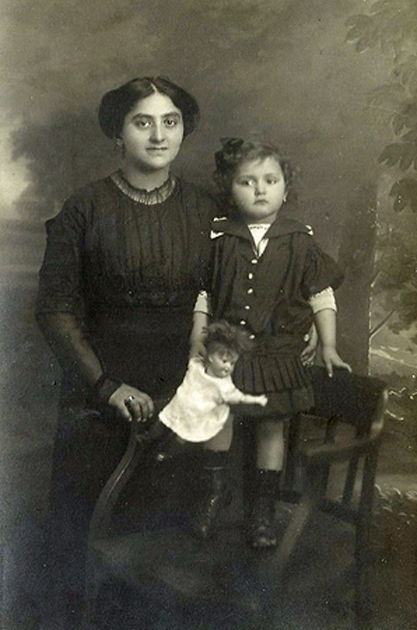
Here is Hermann Rosenbaum in 1916:
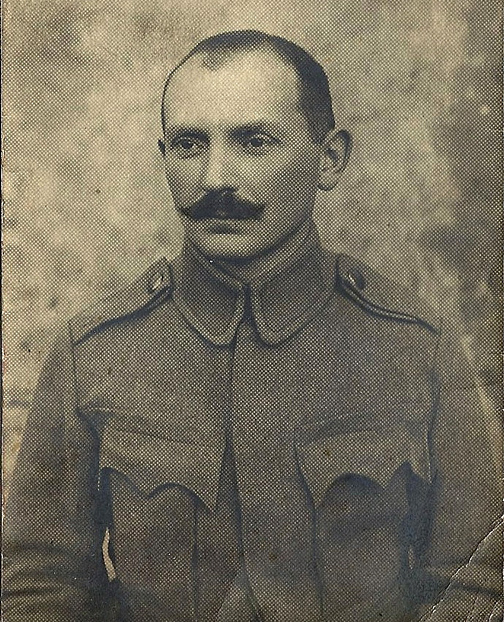
And here are all three, in 1938.
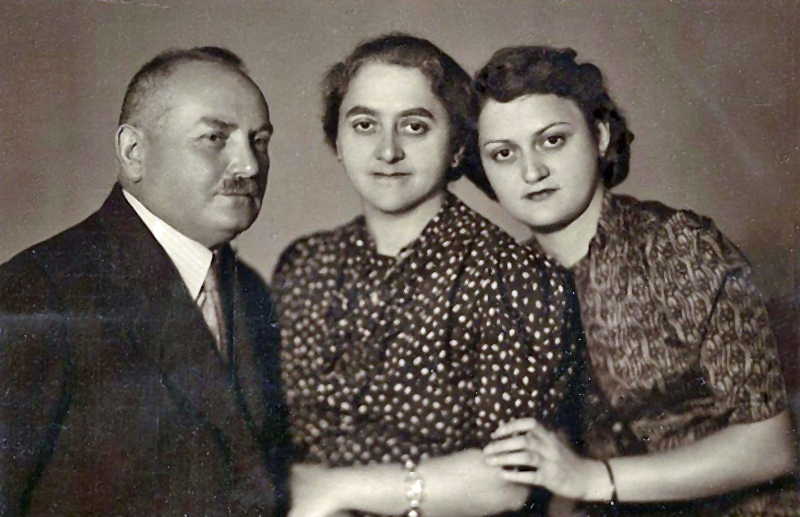
Also, one of the brothers, Martin, died in 1935. It’s safe to say, then, that the group picture was taken somewhere between 1918 — when my grandfather would have come back from World War I — and 1935.
The Fashion Guide
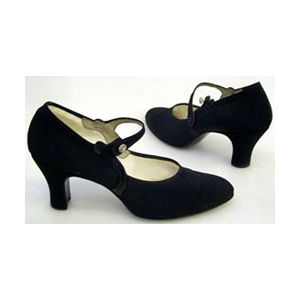 I figured looking at the clothing worn by the siblings would help narrow the date down a bit.
I figured looking at the clothing worn by the siblings would help narrow the date down a bit.
Based on the women’s shoes — all of which are remarkably alike, though they’re obscured in the photo — I’d have to guess the picture was taken in the 1920s. According to the Vintage Inspired Clothing blog, “the biggest fashionable shoe style of the 1920’s was the T-strap or the T-bar heeled pump. The side strap closed at on side with a button or sometimes two.”
This would put the siblings’ ages between late 30s and early 50s, which seems reasonable.
The rest of the women’s clothing is no help, at least to me. Hemlines, necklines, purses — and why doesn’t Mally Kornmehl have one? — are all over the fashion spectrum. So are the hairstyles.
It would be useful to know more about their life circumstances, aside from the fact that the three women on the right were married to butchers and the one with the white fox boa was married to a cafe owner. They all seem reasonably affluent and therefore able to afford nice clothing, but were they dowdy matrons — only Mizzi Schmerling, second from the left, looks at all glamorous — dressing up in older clothing for a special occasion, or was this the height of Viennese style? Viennese Jewish style? Viennese Jewish butcher’s wives style? I got too depressed trying to track down the popularity of those fox boas to continue searching.
Then there are the men’s facial hair styles. Here again, all are remarkably similar: clean-shaven with small, trim mustaches. The lush upper lip of my grandfather during World War I is gone. Only one of the brothers-in-law, the “other” Siegmund Kornmehl, has a beard — and what a beard! It makes him look older than the rest — not to mention like one of the Smith Brothers, of cough drop fame — but he was born in 1875, making him exactly the same age as Martin.
The search for a history of men’s facial hair on the internet also led me to places I didn’t want to venture, places with pictures of soul patches and Z Z Top.
I wrote for advice to the Wien (Vienna) Museum, which has a fashion collection along with other artifacts of everyday life in Vienna, but so far got no response.
Do any of you family historians or fashion mavens have any ideas about how to further pinpoint the date of this picture? I won’t get my feelings hurt — well, not too much — if you send me back to the archives to search for significant events in my family’s life. But I thought it would be fun to try.
Update: I got a very nice long email this morning from Wien Museum curator Dr. Martina Nußbaumer, which started off: “Thank you for your interest in the collections of the Wien Museum and for your information about the most interesting history of the Kornmehl family.” How can you not love a museum that calls your family’s history “most interesting!” She offered help with several other topics I inquired about, including cafes and butcher shops, and suggested that the family portrait dates from the mid/late 1920s.
And another staff member at the museum, Susanne Breuss, was generous enough to offer to post the picture on her own blog about history and everyday life in Vienna, which looks fascinating. Stay tuned.

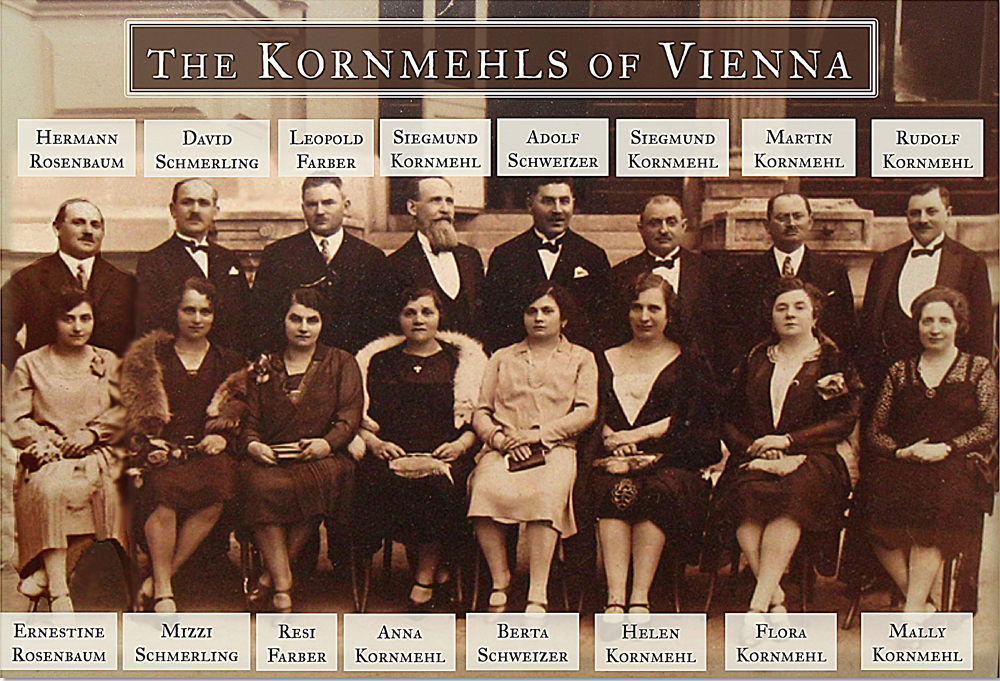
I don’t know Edie i am no expert but to me the feel of the women’s attire and hair do’s seems already early forties. I was a child in Vienna right after the war and the appearance of these ladies was not so different from what I think I remember seeing then. Just intuiting, nothing sure.
Sadly, the family was broken up by the early 1940s — they all left Vienna by 1938 or were sent off to concentration camps in the early 40s. But I see, through you, that I need to clarify this. Thanks for your input.
Are there are 2 Siegmund Kornmehls? One has a beard and one without? Isn’t that odd to name two people the same name in similar generations? Or is one Stegmund or Sirgmund and I am just unable to read the fine print?
Just guessing on the fashion, maybe mid to late 20s.
One of the Siegmunds is a brother-in-law — a distant cousin — and one is a brother (yes, one of the sisters married a man with the same name as her brother). It took a while to figure that one out.
Thanks for the guess.
I have no suggestions but I wish I did. I am at least half as fascinated as you are! It’s a good historical mystery! I can’t wait to find out more.
Thanks, Kristine. Getting others interested is more than half the battle here… Happy New Year!
So much to ponder about….the picture hides secrets we need to uncover.
Why are some of the men wearing long ties, others wearing bow ties? Why are two women wearing furs?
Is Resi angry? Why is Sigmund (Anna’s husband) the only with a beard???
Time will tell what secrets can be uncovered. In the meantime, it is wonderful that such a picture exists and gives us pause for thought and questions…
Ah, someone else who is getting into the spirit! I was thinking of covering a few of those topics — the one about ties in particular — in another post: For what occasion do some people wear formal wear, others less formal?!
I think *eight* such pictures exist. We know for sure that Gigi Michaels has one, inherited from her grandfather, Rudolf Kornmehl. This means her copy went to Shanghai to Canada and Israel and made it all the way to America. I’d love to know if any of the other versions survive — and where they’ve been.
Fascinating stuff–I wonder how exactly this photo could probably be dated, given the right source of info, the right expert looking at it. (Have you thought of taking it to the Metropolitan in NYC? Isn’t there a costume department there?) It has to be easier to guess at the earlier limiting date, since certain fashions didn’t come in until a definite date. But the “no-later-than” date would be harder, since perhaps women (and men) held onto and went on wearing their good clothes (if, as you wonder, these were indeed special occasion clothes) after the fashion may have declined a bit. The men’s hairstyles, on the other hand, might be an easier clue, since many men probably got a fresh haircut every week.
I don’t remember if I told you I have a note written on hotel stationery from a Boston hotel commemorating the get-together (at the hotel for dinner) of a group of ancestors of mine, brothers and sisters (and brothers- and sisters-in-law), in the 1860s or so, signed by them all, on the occasion of a birthday. They were a close, affectionate, mutually-helpful lot, on the whole, and your photo makes me think of that. Could your ancestors have also gathered on the occasion of a birthday or important wedding aniversary? The children were obviously left at home, and the parents were gone by then. Were chairs hauled out onto the sidewalk? Did passersby stop and watch the photographer setting up, etc.? Interesting to think about.
Well, I haven’t given up hope for the Vienna Museum and its fashion department yet — especially if I go there. I would imagine fashions in Europe are slightly different than those in the U.S. — though of course the Metropolitan Museum would have information from all over the world, wouldn’t it?
It’s funny, I didn’t even think of the men’s hairstyles, only their facial hair, but that’s certainly another factor to consider.
I also like the birthday/anniversary idea. If it was a wedding/bar mitzvah, you would expect the bride or the bar mitzvah boy to be there and this is an all adult occasion, as you point out. Something else to throw into the hopper.
Yes, I thought about the building, which is hard to see in this version, because it’s a bit obscured by the names. It looks very grand for an events hall, doesn’t it? I tried to look up large synagogues to see if there was anything similar, but I couldn’t find anything.
I wouldn’t give up on the hairstyles quite yet. At least Mizzi, Resi, Anna and Helen are wearing variants on the Marcel wave or finger wave. (Can’t really see Ernestine and Berta, but they could be also. The parts are there.) Low part with a ‘flat’ areas adjacent, and then waves. You might want to check this out. Says to me mid 20s to early 30s, but I’m no expert.
And they weren’t necessarily dowdy… They were respectable married ladies, and it may have been just that kind of event. I’m not sure, but is Mizzi holding a rose? Might mean something.
I’m impressed by your knowledgeable take on hairstyles — thank you, Linda! That’s just the type of inside detail I was hoping for. I can’t see what Mizzi is holding very clearly either, and I’ve been staring at the original. I’ve been trying to tease something out of the fact that Mally doesn’t have a purse — that makes me think maybe it’s an event relating to her family…
When was the Titanic? The men — from what we see — might look like what the upper class wore on the Titanic especially the men wearing the tie around the neck almost like a tuxedo top.
Do you look more like your mother or your father? Just curious.
The Titanic sunk in 1912 — too early. As for your second question, I don’t really look like either of them, but I have more of the same shape face as my father, whereas my sister looks more like our mother.
I love your use of vintage fashion sites to date this photo. Very creative.
I can respond to one of your queries–Viktor Frankl became bar mitzvah in Vienna in 1918. His family was observant to some extent–his father praying the Shema every day with phylacteries, and the family kept kosher until shortages in World War I made it difficult to continue. I assume he was not that different many Viennese Jews of that time and that level of observance; i.e., I don’t think he was the only Jew to become bar mitzvah at that time.
You may already have used this resource, but I thought I would mention it, as I found it very helpful when I was researching Frankl’s biography in a visit to Vienna–the Jüdisches Museum on Dorotheergasse: http://http://www.jmw.at/en
Thank you for the information that Viktor Frankl was bar mitzvahed, Anna. That’s very helpful. I’m sure you’re right that he wouldn’t have been the only one. It’s funny, when I was growing up girls never had bat mitzvahs but now it’s very popular. So religious fashions change. Do you know if Frankl had a party of the kind that might make a family get dressed up in the way that this one did?
And it’s an excellent idea to contact the Jewish Museum with such questions. I didn’t think of it — thank you again!
I don’t know if Frankl had such a party. I don’t know, either whether it was held during or after the war, which might have dictated the level of celebration.
Thanks, Anna. You’re right, anything held during the war would not have been very festive, would it.